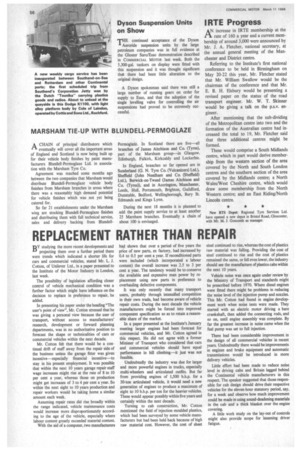REPLACEMENT RATHER THAN REPAIR
Page 58

If you've noticed an error in this article please click here to report it so we can fix it.
Bstudying the more recent developments and 1-1 projecting them over a further period there were trends which indicated a shorter life for cars and commercial vehicles, stated Mr. L. J. Cotton, of Unilever Ltd., in a paper presented to the Institute of the Motor Industry in London, last week.
The possibility of legislation affording closer control of vehicle mechanical condition was a further factor which might have influence on the decision to replace in preference to repair, he added.
In presenting his paper under the heading "The user's point of view", Mr. Cotton stressed that he was giving a personal view because the user of transport, without access to manufacturers' research, development or forward planning departments, was in no authoritative position to forecast the shape or technicalities of cars or commercial vehicles within the next decade.
Mr. Cotton felt that there would be a continual drift of staff away from the repair side of the business unless the garage fitter was given incentive—especially financial incentive—to stay in his present employment. It was possible that within the next 10 years garage repair staff wage increases might rise at the rate of 8 to 10 per cent a year, whereas those on production might get increases of 3 to 4 per cent a year. So within the next eight to 10 years production and repair workers would be taking home a similar amount each week.
Assuming repair rates did rise broadly within the range indicated, vehicle maintenance costs would increase more disproportionately according to the age of the vehicle, especially where labour content greatly exceeded 'material content.
With the aid of a computer, two manufacturers had shown that over a period of five years the price of new parts, ex factory, had increased by 0.4 to 0.5 per cent a year. If reconditioned parts were included (which incorporated a labour content) the overall increase was 2.5 to 3 per cent a year. The tendency would be to conserve the available and expensive man power by replacement using new parts in preference to overhauling defective components.
It was only recently that many transport users, probably through intensified competition in their own trade, had become aware of vehicle repair costs. During the next decade the vehicle manufacturers might be forced into improved component specification so as to retain a reasonable share of the market.
In a paper presented at the Institute's January meeting larger engines had been forecast for commercial vehicles, and Mr. Cotton agreed in this respect. He did not agree with a former Minister of Transport who considered that cars and commercial vehicles should have equal performance in hill climbing—it just was not feasible.
Undoubtedly the industry was due for larger and more powerful engines in trucks, especially multi-wheelers and articulated outfits. But far from providing engines of 1,500 b.h.p. for a 30-ton articulated vehicle, it would need a new generation of engines to produce a maximum of eight to 10 b.h.p. per ton for the heavier vehicles. These would appear possibly within five years and certainly within the next decade.
Turning to cab construction, Mr. Cotton mentioned the field of injection moulded plastics, which had been surveyed by some vehicle manufacturers but had been held back because of high raw material cost. However, the cost of sheet steel continued to rise, whereas the cost of plastics raw material was falling. Providing the cost of steel continued to rise and the cost of plastics remained the same, or fell even lower, the industry should see the manufacture of plastics cabs within the next 10 years.
Vehicle noise was once again under review by the Ministry of Transport and standards might be prescribed before 1970. Where diesel engines were fitted there might be problems in reducing the noise level of the injection pump and nozzles. This Mr. Cotton had found in engine development work when noise tests were made. They started with an electric motor driving a bare crankshaft, then added the connecting rods, and so on, until engine assembly was complete. By far the greatest increase in noise came when the fuel pump was set to full injection.
There had been considerable improvement in the design of all commercial vehicles in recent years. Undoubtedly there would be improvements in engines and brake equipment and automatic transmissions would be introduced in more delivery vehicles.
Little effort had been made to reduce noise level in driving cabs and Britain lagged behind the Continental vehicle manufacturers in this respect. The speaker suggested that those responsible for cab design should drive their respective vehicles for the eleven-hour statutory period, say, for a week and observe how much improvement could be made in using sound-deadening materials in the cab and a thick blanket over the engine covering.
A little work study on the lay-out of controls might also provide scope for lessening driver fatigue.








































































































































